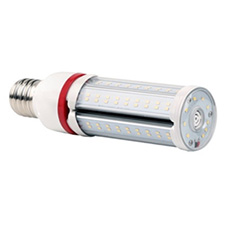
Guiding Light: High-Bay LEDs Illuminate the Path to Efficiency
Chuck Ross
High-bay fixtures are among the unsung heroes of indoor illumination. Without them, sporting events, and big box stores would have a difficult time operating. and warehouse employees might need flashlights to navigate aisles. High-bays are designed for functionality rather than looks, given how high they’re usually mounted, so specifiers can treat them more like necessary commodities than as an important contributor to the ways future occupants will experience a space.
In fairness, until recently, high-bays have offered a pretty minimal level of performance, beyond their ability to meet the demand for high lumen output. Metal halide (MH) lamps were first marketed for these applications in the 1990s and became a go-to solution soon after because of their improved color rendering and output capabilities. These advantages, however, came with drawbacks that facility managers had to accept, including relatively high cost (compared to yellow-hued high-pressure sodium lamps). And the cost factor is especially important given MH lamps’ relatively short 6,000- to 15,000-hour lifespan and that the time they need to fully warm up means they’re often left on, even when not needed, to ensure light is available when it is needed. Since MH lamps can’t be dimmed, they’re operating at full power whenever they’re switched on.
As they have throughout the lighting industry, LEDs have shifted these economics considerably. Initial cost for an LED lamp or fixture might not be far off that for an MH version, but LED products can last 50,000 hours or more before they need replacement. In addition to cutting lamp expense, this fact leads to lower maintenance costs, which can be significant, requiring lifts in some cases, in high-bay applications. Also, because they offer instant-start illumination, there’s no need to turn them on when light isn’t needed, which adds even more years to their operation. Dimming is also an option with LED products, offering greater ability to tailor light output to actual needs. And, most obviously, LEDs far outpace MH products on efficiency, matching their output at sometimes half the wattage.
In fairness, until recently, high-bays have offered a pretty minimal level of performance, beyond their ability to meet the demand for high lumen output. Metal halide (MH) lamps were first marketed for these applications in the 1990s and became a go-to solution soon after because of their improved color rendering and output capabilities. These advantages, however, came with drawbacks that facility managers had to accept, including relatively high cost (compared to yellow-hued high-pressure sodium lamps). And the cost factor is especially important given MH lamps’ relatively short 6,000- to 15,000-hour lifespan and that the time they need to fully warm up means they’re often left on, even when not needed, to ensure light is available when it is needed. Since MH lamps can’t be dimmed, they’re operating at full power whenever they’re switched on.
As they have throughout the lighting industry, LEDs have shifted these economics considerably. Initial cost for an LED lamp or fixture might not be far off that for an MH version, but LED products can last 50,000 hours or more before they need replacement. In addition to cutting lamp expense, this fact leads to lower maintenance costs, which can be significant, requiring lifts in some cases, in high-bay applications. Also, because they offer instant-start illumination, there’s no need to turn them on when light isn’t needed, which adds even more years to their operation. Dimming is also an option with LED products, offering greater ability to tailor light output to actual needs. And, most obviously, LEDs far outpace MH products on efficiency, matching their output at sometimes half the wattage.
Photo courtesy of Morris Products



